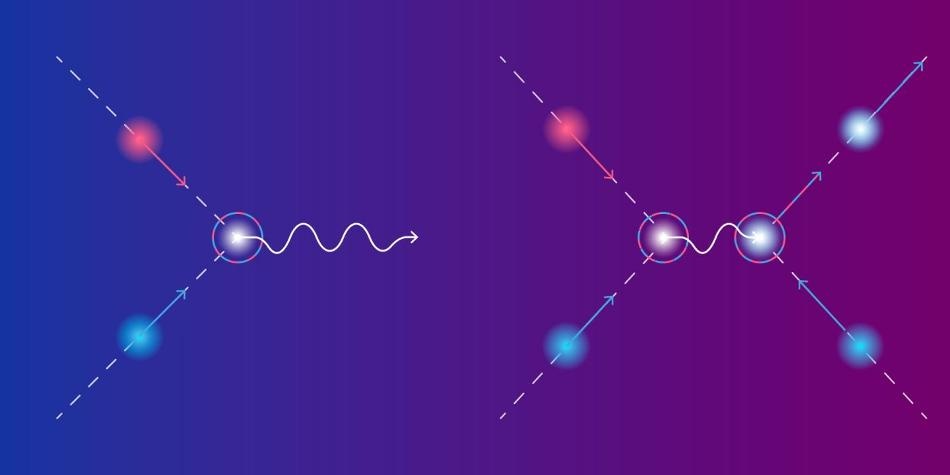Jun 21 2018
Scientists at the Moscow Institute of Physics and Technology and Tohoku University, Japan, have interpreted the obscure phenomenon of particle-antiparticle annihilation in graphene, which experts consider as Auger recombination. In spite of being observed constantly in experiments, for a long time, it was considered to be restricted by the basic physical laws of energy and momentum conservation. Until recently, the theoretical interpretation of this phenomenon has been one of the greatest riddles of solid-state physics. The theory elucidating the process has been reported in the Physical Review B journal.
 Two scenarios of electron-hole recombination in graphene. In radiative recombination (left), the mutual annihilation of an electron and a hole, shown as blue and red spheres respectively, frees energy in the form of a photon, a portion of light. In Auger recombination (right), this energy is picked up by an electron passing by. The Auger process is harmful for semiconductor lasers, because it consumes the energy that could be used to produce laser light. For a long time, the Auger process was considered to be impossible in graphene due to the energy and momentum conservation laws. (Image credit: Elena Khavina/MIPT Press Office)
Two scenarios of electron-hole recombination in graphene. In radiative recombination (left), the mutual annihilation of an electron and a hole, shown as blue and red spheres respectively, frees energy in the form of a photon, a portion of light. In Auger recombination (right), this energy is picked up by an electron passing by. The Auger process is harmful for semiconductor lasers, because it consumes the energy that could be used to produce laser light. For a long time, the Auger process was considered to be impossible in graphene due to the energy and momentum conservation laws. (Image credit: Elena Khavina/MIPT Press Office)
In 1928, it was hypothesized by Paul Dirac that an electron has a twin particle, which is identical in every aspect other than its opposite electric charge. This particle, known as the positron, was later discovered through experiments. Many decades later, researchers identified that the charge carriers in semiconductors such as germanium, silicon, gallium arsenide, and so on act like electrons and positrons.
The two types of charge carriers in semiconductors were called electrons and holes, with their respective negative and positive charges. They have the ability to recombine, or annihilate each other, thereby liberating energy. The working principle of semiconductor lasers, devices that are highly significant for optoelectronics, is electron-hole recombination followed by the emission of light.
Light emission is not the only probable consequence of the interaction of an electron with a hole in a semiconductor. Usually, the emitted energy is lost to thermal vibrations of the adjacent atoms or absorbed by other electrons. The latter process is known as Auger recombination and is the chief “killer” of active electron-hole pairs in lasers. It has been named after Pierre Auger, the French physicist who studied these processes. Laser engineers make efforts to increase the probability of emission of light during electron-hole recombination and to inhibit all the other processes.
This is why the optoelectronics community eagerly welcomed the proposal for graphene-based semiconductor lasers designed by MIPT graduate Victor Ryzhii. According to the basic theoretical concept, Auger recombination in graphene should be suppressed by the energy and momentum conservation laws. The laws are mathematically identical for electron-hole pairs in graphene as well as for electron-positron pairs in Dirac’s original theory. Moreover, it is a long-known fact that electron-positron recombination through the transfer of energy to a third particle is impracticable.
Yet, experiments performed using hot charge carriers in graphene persistently provided the unfavorable outcome: it is certain that electrons and holes in graphene recombine with a relatively high rate, and the phenomenon seemed to be due to the Auger effect. Furthermore, it took less than a picosecond (or one-trillionth of 1 second) for an electron-hole pair to vanish—hundreds of times rapid when compared to contemporary optoelectronic materials. The experiments indicated that it is difficult to implement a graphene-based laser.
The scientists from MIPT and Tohoku University discovered that the recombination of electron-hole pairs in graphene, suppressed by the classical conservation laws, is rendered feasible in the quantum world by the energy-time uncertainty principle. It hypothesizes that conservation laws may be violated to an extent inversely proportional to the mean free time of the particle.
Due to the formation of a strongly-interacting “mash” by the dense carriers, the mean free time of an electron in graphene is extremely short. The so-called nonequilibrium Green’s functions method was devised in modern quantum mechanics to systematically explain the uncertainty of particle energy. This strategy was adopted by the paper’s authors to compute Auger recombination probability in graphene. The acquired predictions are in good accordance with the experimental data.
The research not only provides an explanation for the possibility of the “prohibited” Auger process. Most significantly, it defines the conditions under which this probability is low enough to ensure viability of graphene-based lasers. Since particles and antiparticles quickly disappear in experiments with hot carriers in graphene, the lasers can harness the low-energy carriers, which are proposed to have longer lifetimes, based on the calculations. At the same time, the first experimental proof for generation of laser pulses in graphene has been acquired at Tohoku University in Japan.
Specifically, the technique for calculating the electron-hole lifetimes devised in the paper is not restricted to graphene. It can be applied to a broader category of so-called Dirac materials, in which the behavior of charge carriers is similar to that of the electrons and positrons in Dirac’s original theory. Initial calculations show that the mercury cadmium telluride quantum wells could allow considerably longer carrier lifetimes, and hence more effective laser generation, since the conservation laws for Auger recombinations in this instance are more restrictive.
The research was supported by the Russian Science Foundation.